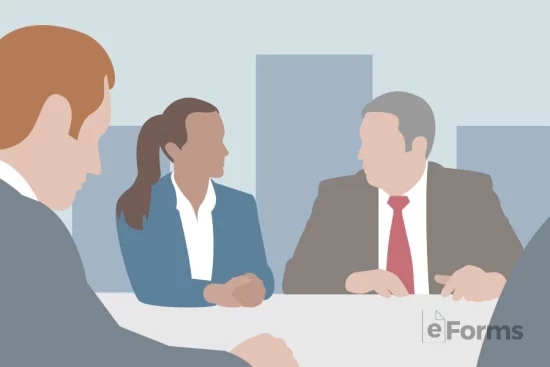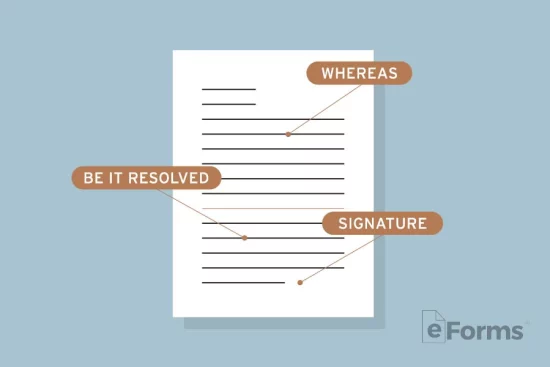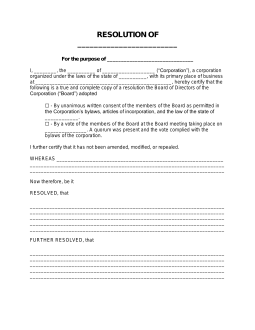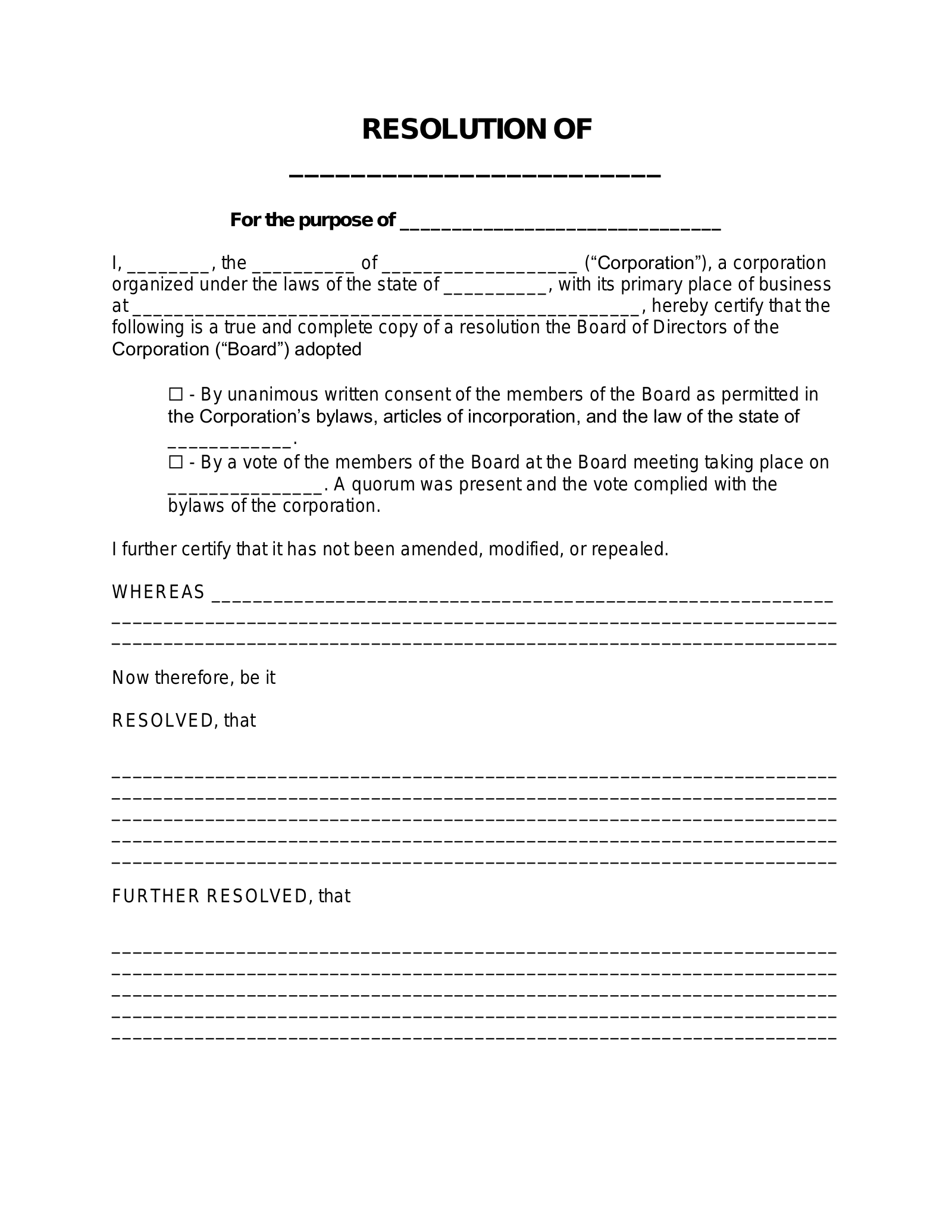Updated October 11, 2023
A resolution is a legal document that serves as proof of a decision made by a board or managing members of a corporation or organization. Generally, a resolution records a decision that is binding or more important than a day-to-day decision, such as whether to adopt bylaws or who to appoint as executives.
Reasons to Use
- Buying real estate
- Hiring top-level executives
- Firing certain employees
- Adjusting the operating agreement
- Opening a bank account
- Establishing an annual budget
- Initiating litigation
- Resolving conflict
Table of Contents |
By Type (4)
 Board Resolution – A board resolution is similar to a corporate resolution, except it is signed and executed by the members of limited liability corporations (LLCs), which operate slightly differently than corporations.
Board Resolution – A board resolution is similar to a corporate resolution, except it is signed and executed by the members of limited liability corporations (LLCs), which operate slightly differently than corporations.
Download: PDF, MS Word, OpenDocument
 Corporate Resolution – A corporate resolution is used to catalog decisions made by a board of directors who report to the shareholders of a C corporation or an S corporation.
Corporate Resolution – A corporate resolution is used to catalog decisions made by a board of directors who report to the shareholders of a C corporation or an S corporation.
Download: PDF, MS Word, OpenDocument
 Partnership Resolution – Used by all types of partnerships to make large decisions that impact business partners.
Partnership Resolution – Used by all types of partnerships to make large decisions that impact business partners.
Download: PDF, MS Word, OpenDocument
What is a Resolution?

A resolution is a legal document that records an important decision reached by the officers of a company or organization. The document includes information about the people who voted on the decision at hand and how they voted. Often it also indicates the manner in which the vote was taken and where the vote occurred.
Resolutions are not necessary for simple decisions, such as hiring an entry-level employee or making a small purchase. Generally, they are used to record decisions that could be scrutinized in an audit or lawsuit.
Corporate vs. Board Resolution
A corporate resolution is used by a corporation; the latter is utilized by a limited liability company, or LLC, to document its decision-making process. Where corporations are owned by their shareholders and managed by boards of directors, LLCs are owned and managed by individuals, known as members. Where corporations are structured and guided by bylaws, LLCs abide by operating agreements.
How Long to Keep?
The recommended length of time for keeping resolutions on file varies according to the nature of the expense or event to which they pertain. Generally, the Internal Revenue Service recommends keeping corporate records on file for between two and seven years. Many lawyers suggest 10 years.
Some resolutions should be retained indefinitely, such as those that document the adoption of bylaws and record leases, deeds, or mortgages.
Common Terms

It’s generally accepted that resolutions should adhere to a specific format, which involves formal and particular language.
The first part of the resolution lays out the context for the decision being made, and in this section, each line begins with the word WHEREAS. In legal parlance, this term denotes the laying out, or building, of an argument. These WHEREAS statements in a resolution are known as recitals.
Recitals
A recital in a resolution might read: “WHEREAS, the shareholders of Sam Jones Inc. recognize the intention of the corporation to open a bank account through Mark Jones Bank…”
Resolutions
Following the recital statements, a resolution will include some variation of the statement “Therefore, it is resolved,” and then the document will move into memorializing the actual decision being made. In this section, sentences begin with the phrase BE IT RESOLVED. These are known as resolutions, or actions. An example might be:
“BE IT RESOLVED that Sam Jones Inc. will open an account at Mark Jones Bank…” or, “BE IT RESOLVED that Peter Daniel, treasurer of Sam Jones Inc., will transfer funds into the account at Mark Jones Bank…”
Here are some other terms to know that are affiliated with resolutions:
- Quorum: This term refers to the minimum number of people who must be present for a vote in order that it can be valid and recorded in a resolution. This minimum number is typically outlined in the organization’s bylaws or operating agreements. If a quorum is not achieved, a decision cannot be legally made or legally binding, and therefore a resolution is moot.
- Unanimous: This term refers to a full consensus. A unanimous vote is one that leans in one direction, and in which there are no dissenters. If a decision is unanimous, it’s important for the resolution recording that decision to indicate this.
- Minutes: Resolutions passed at meetings should be referenced in the meeting minutes, which are required records that offer a long-term view of an organization’s behavior and evidence of its adherence to statutes and internal rules.
- Rescind: To rescind a resolution is to revoke it, or undo it.
- Revoking Resolution: A revoking resolution is a resolution that undoes, or revokes, a previous resolution.
Key Elements of a Resolution

It’s generally accepted that resolutions should be short. A resolution will typically begin with information about:
- the organization:
- what it’s called,
- the state in which it’s organized, and
- its place of business.
Some resolutions list the statutes under which their organization was established. A resolution will then include details about the meeting at which the resolution was passed, including the date, time, and location. Next are the details of the decision, including an indication of how many people voted.
This information will be followed by the recitals and resolutions. The resolution will conclude with the signatures and printed names of the officers authorized to sign the resolution. Dates should accompany signatures. If applicable, a corporate seal should also be affixed to the resolution.
Signing Authority

The directors of a board or members of a corporation can collectively sign a resolution to certify its validity.
In addition, while this sounds a lot like a self-loop, the authority to sign a resolution can be granted to a specific officer or officers by a resolution. A board can pass a resolution to give general signing authority to (a) designated person(s), or assign more specific and situation-dependent signing authority, such as giving the treasurer the authority to sign checks and the secretary the authority to sign resolutions.
Signing authority resolutions should be signed by an officer of the organization who is not being granted signing authority.


